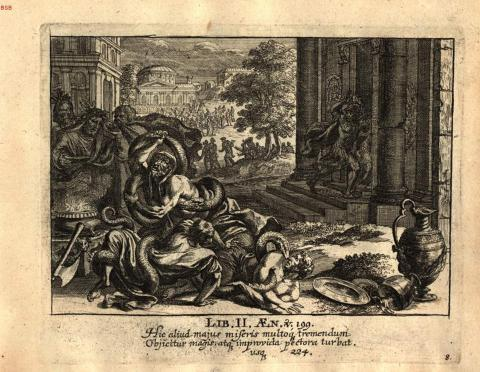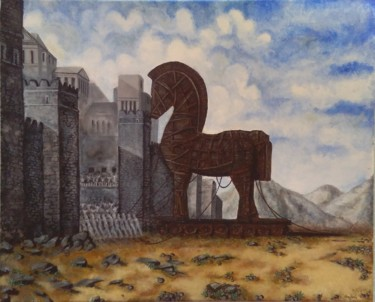3.2 Vergil, Aeneid, Book 2, Lines 201–249
6 min read•june 18, 2024
Jack Marso
Mick Polito
AP Latin 🏛
24 resourcesSee Units
Lines 201-249
Vergil continues Book 2 by moving on from Sinon, who just completed his eerie speech of his experience as a Greek sacrifice and how under the assistance of Pallas Minerva and the Trojan horse, if brought into the city, would spark a war. The attention is now focused back on Laocoon, the Trojan Priest.
Before we dive into breaking down the Latin lines into text we can more clearly comprehend, we will answer some questions based on the designated skill categories! The skill categories for these lines are Reading and Comprehension, Translation and Textual Analysis so be aware of that when you answer these questions and read these lines.
Lines 220-227
ille simul manibus tendit divellere nodos
perfusus sanie vittas atroque veneno,
clamores simul horrendos ad sidera tollit:
qualis mugitus, fugit cum saucius aram
taurus et incertam excussit cervice securim.
at gemini lapsu delubra ad summa dracones
effugiunt saevaeque petunt Tritonidis arcem,
sub pedibusque deae clipeique sub orbe teguntur.
Try to answer these questions either on paper, a device, or in your head. Then, review the answers by reading below and referring back to the Latin text above.
- In line 2 of the passage (perfusus...veneno), name one AND only one description that Vergil gives about Laocoon’s headband?
- Translate in context the words clamores AND horrendos AND identify the case of each.
- A stylistic device that occurs in line 5 (taurus...securim) is...
- Translate in context the words saevae AND Tritonidis AND identify the case of each.
- A stylistic device that occurs in line 8 (sub...teguntur) is...
Answers (Don't peek!👀)
- Drenched in dark blood or drenched in dark venom
- Horrendous shouts; accusative plural: Clamores meaning shouts and horrendos meaning horrendous both come from the accusative. Clamores comes from the third-declension masculine noun clamor, clamoris in the nominative and genitive. On the other hand, horrendous comes from the first/second declension adjective horrendus, horrendi in the nominative and genitive
- Alliteration: Alliteration is the repetition of the same letter or sounds together closely amongst words. In line 5, this is completed by single alliteration in between words throughout the sentence repeating a similar “C” sound: Taurus et incertam excussit cervice securum.
- Of savage Pallas; genitive singular: Saevae meaning savage and Tritonidis meaning Pallas, the daughter of Triton, both come from the genitive. Therefore, of is added because genitives are translated of the ____. Saevae comes from the first/second declension adjective saevus, saevi in the nominative and genitive. On the other hand, Tritonidis comes from the third-declension feminine noun Tritonis, Tritonidis in the nominative and genitive.
- Polysyndeton: Polysyndeton is the literary technique opposite of asyndeton where conjugations are now used repeatedly and successively without commas. The conjugation being used is sub in the ablative meaning under. Simply, the phrase translates as they are hidden under the feet of the goddess and under the circle of her shield.
Lines 235-240
accingunt omnes operi pedibusque rotarum
subiciunt lapsus, et stuppea vincula collo
intendunt ; scandit fatalis machina muros,
feta armis. pueri circum innuptaeque puellae
sacra canunt funemque manu contingere gaudent;
illa subit mediaeque minans inlabitur urbi
Translate these lines as literally as possible on your own, then check it with the translation below and revise (if necessary).
Translation (don’t peek👀!)
Everyone girds for the tasks and they arrange the wheels allowing motion under its foundation, and extend hemp ropes around its neck. That motor of fate ascends our walls pregnant with weapons. All over boys, and virgin girls, sing sacred songs, and rejoice to touch the ropes with their hands: Up it sails and passes threateningly into the midst of the city.
Remember if you have different wording than we did, that’s perfectly acceptable! Just make sure the words used have the same meaning attached to them.
Breakdown of Lines 201-249 🔎
- As Sinon, supposedly abandoned Greek conspirator, concludes his speech, convincing the Trojans to bring the horse within the city, Vergil highlights the unexpected fate of Laocoon. First, we learn that Laocoon was a “priest for Neptune, chosen by a lot” and because of that, was sacrificing a “huge bull” in order to find more information about the horse from the gods.
- Suddenly, two serpents, presumably representing Greek kings and twin brothers, Menelaus and Agamemnon, from the island of Tenedos, what would later be where the Greek fleet is hiding before the Trojan horse enters Troy, come into the scene. Their “huge coils” head to the shore from the deep sea as even Vergil “shudders” as he attempts to narrate the incident. The serpent's chests were “raised between the waves”, their “bloody crests” top them, and the rest of their body “glides in the sea” as each “twists its back large with a coil.”
- As the snakes began reaching dry ground, a sound arose. The serpents' “glaring eyes filled with blood and fire” as the snakes “were licking with quivering tongues in their hissing mouth,” exposing the malice that Pallas had when sending them to Laocoon.
- Vergil enlists some narrative commentary from Aeneas as the Trojans grow pale from the sight and flee. The serpent's head lunges straight towards Laocoon, and we find out here that Laocoon’s two sons are with him as well at the altar. Vergil surprisingly kept that part out of the story until now, and in a short time each snake “entangles the bodies of his two sons” while they bite into their “wretched limbs.”

Laocoon with his sons becomes intertwined among the twin serpents. Image Courtesy of the Munich Digitization Center
- Afterward, Laocoon comes to their aid “with spears in his hands”, but he becomes bound with massive coils as well. The snakes encompass his back and waist twice with their “scaly backs.” In a matter of time, Laocoon is conquered by them. In desperation, Laocoon attempts to tear apart the coils with his hands but he is unable to with his “headbands soaked in blood and black venom.”
- At this time, Laocoon begins crying for help from the gods and the shouts are compared by Vergil to those of a wounded bull bellowing as he flees from the altar wounded with an “ill-aimed ax” from its neck. However, the “dragon’s pair” referring to the serpents, flee from the brutal scene to the highest citadel of fierce Pallas, where they become hidden by “the feet of the goddess and under the circle of her shield.”
- The Trojans aren’t aware that the serpents were sent by Minerva, but rather believe that Laocoon has paid for his crimes of striking the “sacred oak with his spear," the sacred oak being that of the Trojan horse. As a result, the Trojans shout that the horse must be let into the city and the goddess’s divinity must be prayed for. It seems like the Trojans weren't so crazy to let the horse in after all--they were doing their best to avoid encountering fates similar to those of Laocoon and his sons.
- The walls of the city are divided and opened because the horse is so large that it won't fit through the gates. In an attempt to please the gods, all work to open up the city as they “place rollings of wheels under the feet” and “stretch hemp ropes around the neck.” However, the Trojan horse is “pregnant with arms," just as Laocoon feared. Boys and unwedded girls sing sacred songs while they pleasingly touch the ropes as it passes by, but the horse still “sails and passes threateningly into the middle of the city.”

The wooden horse is entering the city of Troy. Image Courtesy of Artmajeur
- As the horse enters the city, Aeneas discusses Troy before it was burned and surfaces the pity we feel for the fallen city later on. Even though the Trojan horse was “stopped at the threshold of the gate” and “the arms produced a sound in its belly” four times for each, the Trojans were “blind with rage” and allowed the Trojan horse to sit near the most dedicated citadel where the serpents lie.
- Lastly, Cassandra, the daugher or Priam attempts to warn the Trojans about the Greeks inside the horse. However, she is ignored thanks to her curse. She was cursed by Apollo to have the ability of prophecy but not be believed by anyone whom she informed because she denied his sexual advances. With all of these factors in favor of the Greeks and almost everything going wrong for the Trojans, city meets its demise that day.
Now, we'll be moving on to lines 269-297, so follow along as we continue to review!
Browse Study Guides By Unit
🔥Unit 3 – Vergil, Aeneid, Book 2
🏇Unit 4 – Caesar, Gallic War, Book 4
👑Unit 5 – Vergil, Aeneid, Book 4
☠️Unit 8 – Vergil, Aeneid, Books 6, 8, & 12
⚔️Unit 1 – Vergil, Aeneid, Book 1
🥗Unit 2 – Caesar, Gallic War, Books 1 & 6
🥊Unit 6 – Caesar, Gallic War, Book 5, Part I
🧄Unit 7 – Caesar, Gallic War, Book 5, Part II, Book 6, & Book 7
📚Study Tools

Fiveable
Resources
© 2025 Fiveable Inc. All rights reserved.